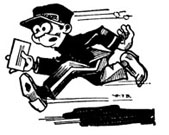
When All Else Fails, “Get Me to a Shopping Mall”
VARIETIES OF DISTRACTING EXPERIENCE
For the last two years I have lived in a town where, surprisingly, there is no abortion clinic. During the 12 years I lived in Milwaukee, however, I frequently paced and prayed on the sidewalks in front of its downtown clinics. Among the many thoughts that drifted though my mind in the course of those countless hours, I remember often being puzzled by the weird, unlikely alliances among the pro-abortion forces. Men with tight shorts, smooth legs, and single earrings chatted amiably with potbellied, bearded, Budweiser-guzzling foundry workers. Either of these types, or both, occasionally could be seen confederated with conservatively dressed east-siders, who sometimes might excuse themselves to answer their cell phones. What could they all possibly have in common, I wondered. But while I wondered, I also watched, and I listened. What I have learned I present in these three composite portraits (the names are fictitious).
Two hours outside of Milwaukee, Mark and Dan purchased and renovated an 1850s farmhouse. Their renovation, however, left little sense of farm in or around the house. Dan created an art studio in the old parlor, Mark landscaped the surrounding acre. A room once merely functional, the bathroom now boasts a skylight, a jacuzzi, and marble surfaces — all colored softly yet brightly. Mark and Dan also built an addition, for entertaining. Rooms are furnished appropriately and expensively in the federal style. The ampage has been tripled. With their dog, Heidi, whom they playfully call their child, Mark and Dan come from the city to the farmhouse on the weekends. Dan paints, Mark cooks and tends the garden. Guests often arrive on Saturday afternoons and, with drinks in hand, they stroll around admiring the effect achieved by some new painting, furnishing, or planting. The music of Kenny G floats in the background. Dinner is at 7:00.
It’s a rich aesthetic experience, these weekends at the “farmhouse.” One thing is for sure, though: Mark and Dan never step in manure.
And that is one objection I have to the whole setting. Restoring the wooden stoop at the front door, installing appropriate 12-over-12 windows in the addition, spending upwards of $15,000 on furniture, rugs, and window treatments, Mark and Dan created the illusion of a 19th-century farmhouse. But it’s not. It’s all too stiff, too prissy, too perfectly kept. Mark would never tolerate a chicken on the property; it might leave droppings in his garden.
Wherever homosexuals are involved in house restoration/renovation, I find this to be true: There’s always a stiff, aesthetic distance between what they imitate and the reality of the thing imitated. Each architectural form, originally, was intended as a symbol of some human value — reason, elegance of life, transcendence, unity with nature, functionalism, commercialism. The homosexual, however, does not restore a colonial, a Victorian, or a Queen Anne because he gives intellectual consent to whatever value is therein expressed. His attraction, simply, is to the aesthetic aspect of the thing. I’ve known homosexuals to be attracted to the Church — or at least to things of the Church — for the same reason. It’s not because they believe in the Body of Christ or the teachings of that Body.
You May Also Enjoy
Angela Watrous's theology: God loves people "regardless of whom they slept with."
If transgender people truly want "equal protection under the law," they shouldn't be treated as a separate class of people, distinct from the rest of society. This is what the inaptly named nondiscrimination laws would do.
The priest and school rector demanded a retraction and apology from the concerned parents or they would not be permitted to enroll their children in the parish school.

